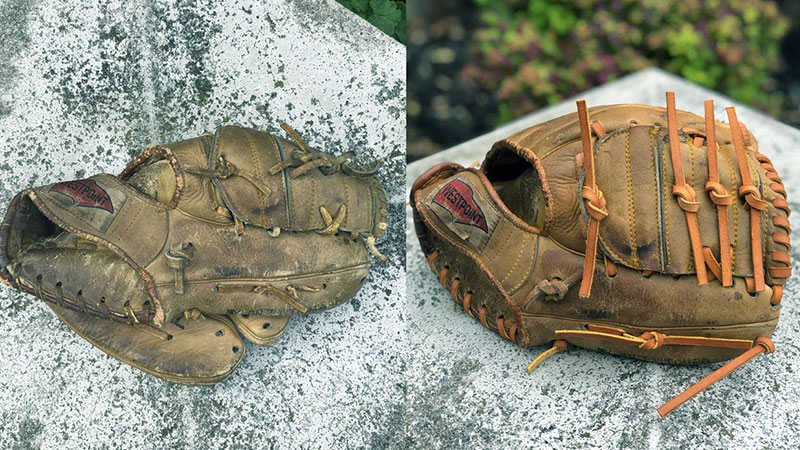Reviving the magic of an old baseball glove is possible through a simple yet effective softening process.
Over time, baseball gloves can become stiff and rigid, losing their ability to perform optimally on the field. However, with the proper techniques, restoring the glove’s suppleness and flexibility is possible, breathing new life into it.
Whether you’re a seasoned player with a cherished glove or a newcomer looking to revive a hand-me-down, softening an old baseball glove is worthwhile.
This comprehensive guide will explore how to restore an old baseball glove, give tips for helping you unlock its full potential, and ensure a comfortable and reliable tool for catching those game-winning plays.
Why You Need to Know How to Soften Old Baseball Gloves?
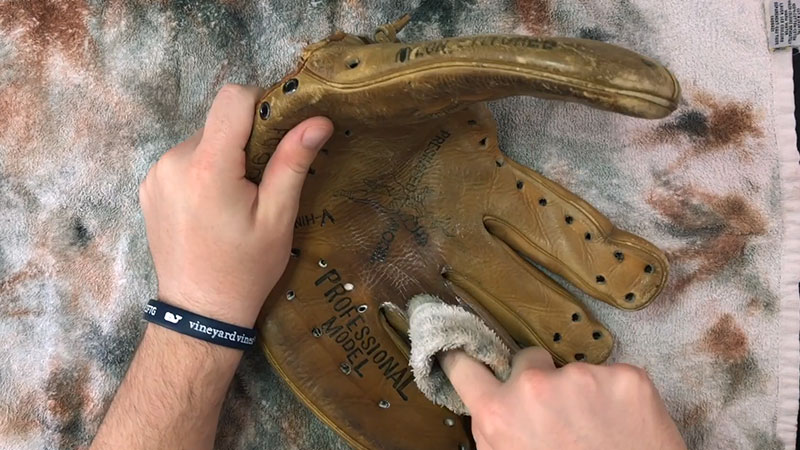
Knowing how to soften an old baseball glove is crucial for players looking to maintain peak performance and comfort on the field.
Over time, baseball gloves can become stiff and rigid, hindering a player’s ability to catch and field balls effectively. Softening the glove restores flexibility, ensuring a better fit and feel during play.
Additionally, a well-softened glove molds to the player’s hand, enhancing control and confidence in every catch. Moreover, reviving an old glove saves money by extending its lifespan and reducing the need for frequent replacements.
Whether you’re a seasoned player with a cherished glove or a newcomer inheriting a hand-me-down, mastering the art of softening ensures that you can unlock the full potential of your equipment, giving you the edge you need to excel on the diamond.
How to Soften Baseball Glove: Ingredients Needed
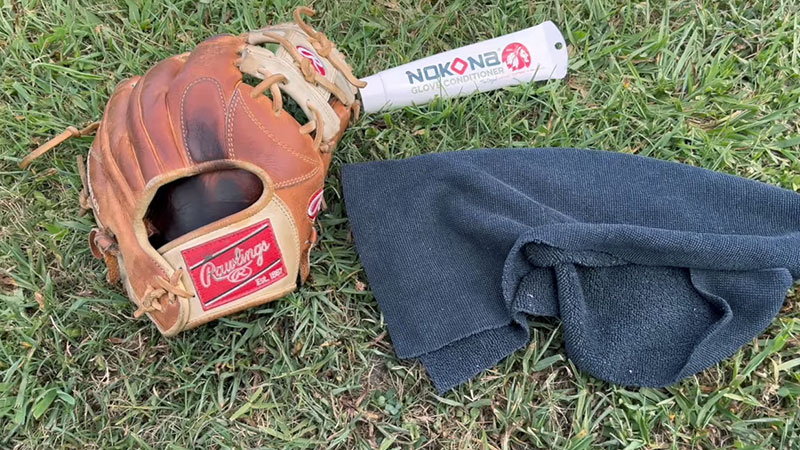
Softening a baseball glove requires specific ingredients and tools to break in the leather and restore flexibility effectively. Here’s a list of the ingredients and tools you’ll need:
- Glove Conditioner or Oil: Choose a high-quality glove conditioner or oil for leather baseball gloves. Popular options include products made from lanolin, neatsfoot oil, or specially formulated glove conditioners.
- Soft Cloth or Sponge: Use a soft cloth or sponge to apply the conditioner or oil to the glove. Avoid using rough or abrasive materials that could damage the leather.
- Rubbing Alcohol or Water: Before applying conditioner or oil, lightly dampen the glove with rubbing alcohol or water to open up the pores of the leather. This allows the conditioner or oil to penetrate more effectively.
- Baseball or Softball: Place a baseball or softball in the pocket of the glove and wrap it with rubber bands or a glove mallet to help shape the pocket and maintain flexibility. At the same time, the conditioner or oil is applied.
- Glove Mallet or Hammer: Use a glove mallet or hammer to pound the glove’s pocket and break in the leather. Focus on areas that need extra flexibility, such as the pocket and fingers, but be careful not to overdo it to avoid damaging the glove.
- Warm, Dry Area: Choose a warm, dry area to work on softening the glove. Avoid extreme heat or direct sunlight, as this can damage the leather. A well-ventilated room or garage is ideal for the process.
- Optional: Leather Softener or Cream: Some players prefer to use additional leather softener or cream with conditioner or oil to soften the glove further.
By gathering these ingredients and tools, you’ll have everything you need to effectively soften your baseball glove and break in the leather for improved flexibility and performance on the field.
Remember to follow the manufacturer’s instructions for any conditioner or oil used, and take your time to ensure thorough application and proper shaping of the glove’s pocket.
How to Soften an Old Baseball Glove: Step-by-step Instruction
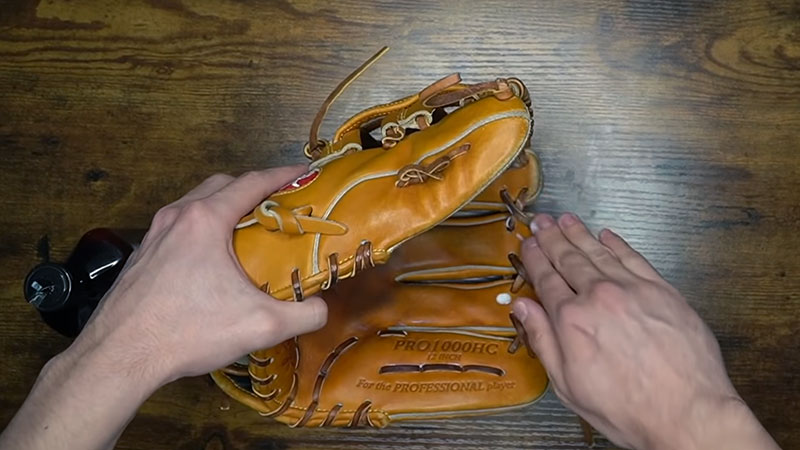
Softening an old baseball glove requires patience, but with the right approach, you can restore flexibility and comfort to your beloved equipment.
Here’s a step-by-step guide to softening an old baseball glove:
Clean the Glove
Start by wiping the glove with a clean, damp cloth to remove dirt or debris. Pay special attention to seams and creases where dirt may accumulate. Allow the glove to dry completely before proceeding.
Apply Conditioner or Oil
Use a soft cloth or sponge to apply a small amount of glove conditioner or oil to the entire glove surface.
Focus on areas that feel stiff or dry, such as the palm, fingers, and pocket. Use gentle, circular motions to work the conditioner into the leather.
Work the Leather
With the conditioner applied, gently flex the glove to work the product into the leather. Pay particular attention to stiff areas, using your fingers to massage the conditioner into the leather fibers.
Shape the Pocket
To help shape the glove pocket, place a baseball or softball in the pocket and wrap it tightly with rubber bands or a glove mallet. This helps stretch and shape the leather, allowing the conditioner to penetrate deep into the fibers.
Allow Time to Absorb
Once the conditioner is applied, allow the glove to sit for several hours or overnight to absorb the product. This gives the conditioner time to soften the leather and restore flexibility.
Repeat as Needed
Depending on the condition of the glove, you may need to repeat the conditioning process several times to achieve the desired softness.
Apply additional conditioner as needed and continue to work the leather until it reaches the desired level of flexibility.
Pound the Pocket
Using a glove mallet or hammer, gently pound the glove pocket to further break in the leather. Focus on stiff or rigid areas, using controlled force to avoid damaging the glove.
Test and Adjust
Once the glove has softened to your liking, please test it on the field to ensure it feels comfortable and performs well. If necessary, make any additional adjustments to the conditioning or shaping process to achieve the desired results.
Maintain Regularly
Regularly apply conditioner and repeat the shaping process to keep your glove soft and supple as needed. Proper maintenance ensures that your glove stays in top condition and provides reliable performance season after season.
By following these step-by-step instructions and taking the time to condition and shape the leather properly, you can soften an old baseball glove and extend its lifespan for years of use on the field.
Appropriate Way to Dried Out Baseball Glove
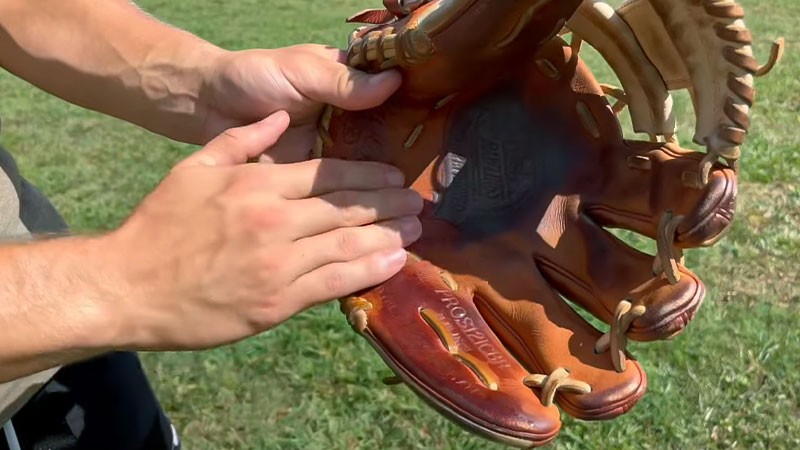
Drying out a baseball glove properly is essential to prevent damage to the leather and maintain its shape and performance. Here’s the appropriate way to dry out a baseball glove:
Remove Excess Moisture
If the glove is wet from rain or sweat, use a dry towel to blot away any excess moisture gently. Avoid wringing or squeezing the glove, which can distort its shape and damage the leather.
Air Dry
Place the glove in a cool, dry, well-ventilated area to air dry naturally. Avoid placing it in direct sunlight or near a heat source, as excessive heat can cause the leather to dry out and crack.
Open the Glove
While drying, open the glove fully to allow air to circulate inside. This helps to prevent the formation of mildew and ensures thorough drying.
Shape the Glove
To maintain the glove’s shape and prevent it from becoming misshapen as it dries, insert a baseball or softball into the pocket. This helps preserve the pocket’s form and ensures the glove retains its intended shape.
Periodically Adjust
As the glove dries, periodically adjust the position of the baseball or softball inside the pocket to ensure that it maintains an even shape. This helps to prevent any areas from becoming overly stretched or distorted.
Be Patient
Allow the glove to air dry completely before using it again. This may take several hours or even overnight, depending on the moisture level.
Rushing the drying process can damage the leather and compromise the glove’s performance.
Optional
Condition the Leather: Once the glove is completely dry, you may condition the leather to keep it soft and supple.
Use a high-quality leather conditioner designed explicitly for baseball gloves, and follow the manufacturer’s instructions for application.
Store Properly
After drying, store the glove in a cool, dry place away from direct sunlight and moisture. Avoid leaving it in a hot car or damp locker, as these conditions can cause the leather to deteriorate over time.
By following these steps, you can effectively dry out a baseball glove without causing damage to the leather or compromising its performance.
Proper drying and maintenance help prolong the glove’s life and ensure that it remains in top condition for many seasons of play.
How to Soften a Stiff Baseball Glove
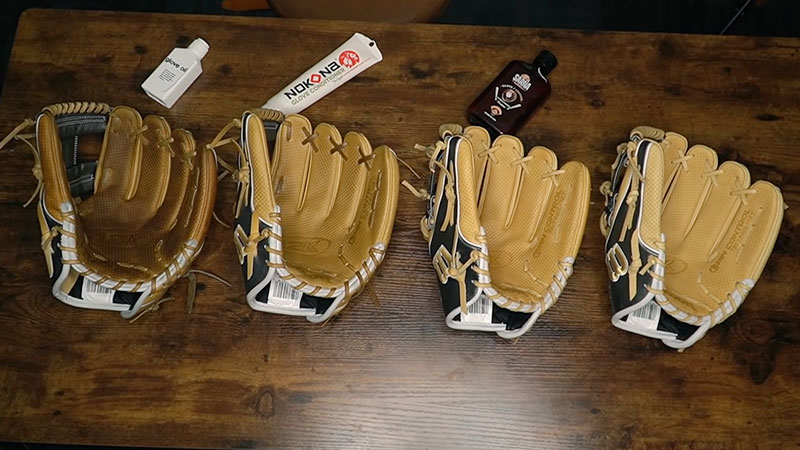
To soften a stiff baseball glove, apply a small amount of specialized glove conditioner or oil to the entire glove surface. Focus on areas that feel particularly stiff, such as the palm, fingers, and pocket.
Gently work the conditioner into the leather using a soft cloth or sponge, then flex and bend the glove to help distribute the product evenly.
Place a baseball or softball in the pocket and wrap it tightly with rubber bands or a glove mallet to help shape the pocket and maintain flexibility while the conditioner penetrates the leather.
Allow the glove to sit for several hours or overnight to absorb the conditioner fully. Repeat the conditioning process as needed until the glove reaches the desired level of softness, then test it out on the field to ensure optimal performance.
FAQs
Can I use household oils like olive oil to soften my baseball glove?
It’s not recommended. While oils like olive oil can soften leather, they may also darken or deteriorate the glove over time. Stick to specialized glove conditioners to ensure optimal results and longevity.
How long does it take to soften a baseball glove?
The time it takes to soften a baseball glove depends on factors like the glove’s condition and the method used. Typically, the leather can take a few hours to a few days to become more supple and flexible.
Can I speed up the softening process for my baseball glove?
Yes, you can accelerate the softening process by using techniques such as repeatedly pounding the glove’s pocket with a mallet, applying leather conditioner, or storing it with a softball or baseball inside the pocket.
Will softening my baseball glove affect its durability?
Properly softening your baseball glove should not significantly affect its durability.
However, excessive use of oils or conditioners may weaken the leather over time. Follow manufacturer recommendations and avoid over-saturating the glove with conditioning products.
Can I use a microwave or oven to soften my baseball glove?
It’s not recommended. Extreme heat from microwaves or ovens can damage the leather and affect the glove’s integrity. Stick to safer methods such as conditioning oils, mallet pounding, and regular use to soften your baseball glove effectively.
Wrapping Up
Mastering softening a baseball glove is essential for players seeking optimal performance and comfort on the field.
Following the techniques outlined in this guide, players can revive their old, stiff gloves and restore them to their former glory.
Whether using conditioning oils, repetitive pounding with a mallet, or storing the glove with a ball inside, these methods offer practical solutions for softening leather and enhancing flexibility.
Softening a baseball glove improves its functionality and preserves its longevity, ensuring that players can continue to rely on their trusted equipment for seasons to come.
With the proper care and attention, every player can enjoy the magic of a well-softened baseball glove.

